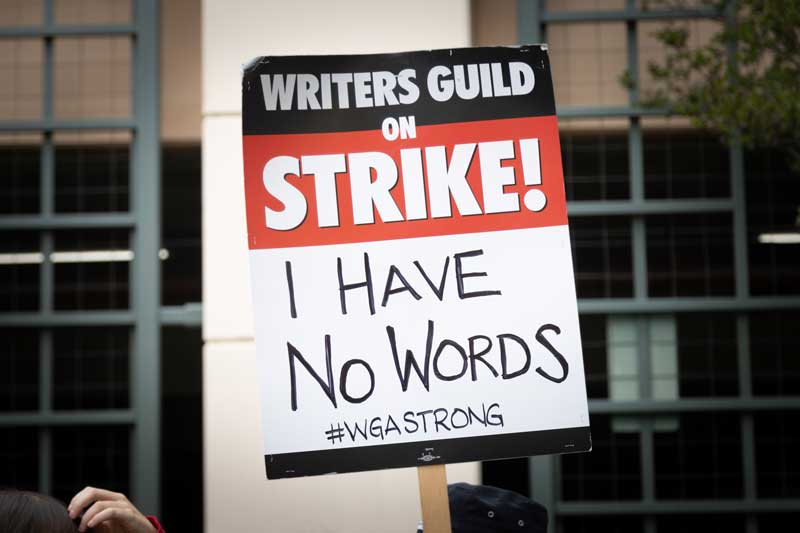A strike in the world of entertainment was averted during the month of July. The two sides reached a tentative agreement on a new contract just before a vote was held on whether to authorize a potential strike that could have shut down the industry. The industry in this case was Broadway, and the workers were crew members involved with more than 40 shows, both touring and on Broadway.
That potential strike was not the one from the entertainment world that has been in the headlines, though. Earlier in July, one strike in the entertainment industry led to another. The Hollywood actors’ union approved a strike after negotiations over a new contract with studios fell apart. That meant for the first time since 1960, both actors and writers were on strike at the same time. The writers have been on strike since May. Here’s what they’re fighting for, and the role data plays in the work stoppages.
A common theme
The last time the Writers Guild of America went on strike was in 2008. That strike lasted 100 days and centered on the distribution of revenue from television shows, movies, and other creative works when they are distributed on the internet. In the 1970s and 1980s, writers’ strikes resulted in salary hikes and residual payments for movies on video cassette and pay television. Years before that, there were writers’ strikes to determine script ownership and the matter of residuals for the showing of theatrical releases on free television.
Each strike addressed some form of technology that had developed that affected the way money was made. Television created a new way to watch movies, video cassette players created a new way to watch television and movies, and the internet changed the way people watched all videos. When the new media proved to be a successful way to continue generating revenue for creative works, the people who created those works wanted to be able to share in the residuals.

Modern technology is a sticking point
This strike is similar in that a newer technology, in this case streaming, has changed the way people watch TV and movies, and it is changing the way studios make money. What has made this strike different and potentially more impactful on the industry is the fact that SAG-AFTRA, the union representing 160,000 television and movie actors, announced it was also approving a strike.
The streaming issue is one negotiating point. From the point of view of the studios, profits from box office returns as well as television viewership have gone down as streaming entertainment has become more popular. For the actors and writers, residual payments from the streaming services are a major contract demand.
Another big issue is the use of artificial intelligence (AI). The writers worry that AI will be used to create scripts, putting them out of a job. The actors want assurances that AI won’t be used to re-create their images in any way that they won’t be compensated for.

The role of data
The distribution of revenue from streaming services is a more complicated issue than it may appear. The writers and actors are asking for payments based on viewership numbers. The problem is, that is data that has been closely guarded by studios in the years since streaming platforms have taken off.
There is a lot of data gathered by streaming services. They can obviously tell how many people are watching certain shows, but that is only the tip of the iceberg. Streaming services can track how long people watch a show or a movie, how many people finish something they start, and decision-making data such as the relationships between certain shows or movies and subscriptions. That is important because the executives can get information on such details as, for instance, if adding a syndicated show bumps up the number of subscribers.

Unlike box office figures or Nielsen ratings that for years have given indications of a show or movie’s popularity, the streaming data is kept out of the public eye. When information about audiences are made public, it is kept vague or given in terms of percentages that have no context to indicate any hard numbers.
The studios argue that some of the data is misleading because a streaming service that has been around for longer has more subscribers, so the numbers for a hit show on a newer streaming service might not be comparable to those on a longer-established service. And how long does someone have to watch a show or movie for it to be considered a ‘view’?
When you consider these complexities, it’s not hard to understand why there has been a work stoppage. Like any other industry, transparency in data is key to being able to make intelligent business decisions. If a stakeholder is left out of the loop when it comes to the information being used to make decisions, that stakeholder is not going to be happy.
No one knows how long the Hollywood strike might last. Production on shows and movies has been halted, and release dates are starting to be delayed. It’s not an ideal situation for viewers, but the way this strike is resolved could help settle issues involving AI and equitable distribution of revenue from new technology in other industries. At the very least it could help underscore the importance of data transparency, and for some organizations that might be worth the wait.
- Analyzing the Challenges of Pharmaceutical Supply Shortages - April 26, 2024
- Summer is an Opportunity for Digital Transformation in Education - April 17, 2024
- Your Car is Tracking More than Miles per Hour - April 11, 2024


